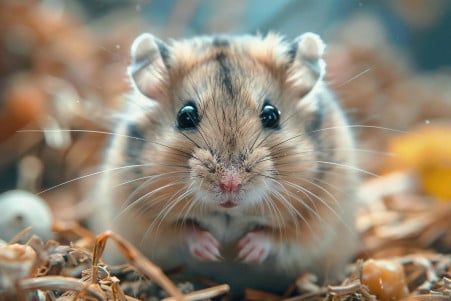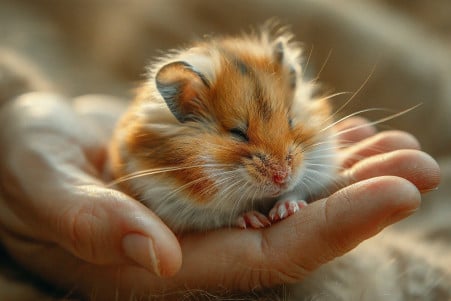Hamsters and Their Tails: What You Need to Know
2 April 2024 • Updated 1 April 2024

If you’ve ever owned a hamster, you’ve probably found yourself wondering whether or not your pet has a tail. While it may seem like a simple question, the answer is a bit more complicated than you might think. Yes, hamsters do have tails, but they’re so small and short that they can be hard to spot.
In fact, the average hamster tail is only about an inch long, and it’s often hidden by the animal’s fur. That said, there are some differences between the tails of different types of hamsters, and some hamsters’ tails are easier to see than others.
So, to help you better understand your pet, we’ve put together this comprehensive guide to hamster tails. We’ll start by discussing the biological function of hamster tails, and then we’ll move on to talk about how hamsters use their tails in the wild. By the end, you’ll know everything you need to know about hamster tails.
Do hamsters have tails?
Hamster Tail Anatomy and Breed Variations
Hamster tails are typically very short and stubby, measuring about an inch or less in length. They are an extension of the spine and are covered in the same thick, insulating fur as the rest of the body, according to Happy Habitats Store. However, there is some variation in tail size across different hamster breeds.
The Chinese Dwarf Hamster is the only hamster species with a tail that is significantly longer than the others, measuring 5-6 cm in length. The slightly prehensile tail helps the Chinese Dwarf Hamster climb by allowing it to grasp branches and shift its weight, according to Small Pet Select. In contrast, the tails of breeds like the Syrian, Roborovski, and Campbell's Dwarf Hamsters are no larger than a grain of rice.
For most burrowing hamster species, shorter tails are more advantageous as longer tails could get in the way as the hamster digs its tunnels. The short, stubby tails help the hamsters navigate the tight spaces of their burrows. The Chinese Dwarf Hamster's longer tail, on the other hand, is better suited to its more arboreal lifestyle, which includes climbing and nesting in trees, and helps it maintain its balance.
What Does a Hamster's Tail Do?
In general, hamsters use their tails for communication and balance rather than for mobility or climbing, according to A hamster's tail - why do they have one and what is it used for?. For example, female hamsters will lift their tails to signal to males that they are ready to mate, a phenomenon that has been observed by scientists. Most hamster breeds have shorter tails, which is an advantage when it comes to burrowing, since longer tails could get in the way of digging tunnels underground, according to the Biology of the Hamster.
Although hamsters have fewer uses for their tails than other rodents, the Cricetulus_griseus study found that the Chinese hamster's tail is slightly prehensile, which can help with climbing and balance. However, Chinese hamsters kept as pets don't have many opportunities to show off their arboreal abilities. In general, a hamster's tail has evolved to meet specific needs based on its environment and behaviors, even if those needs are fewer than those of other rodents.
What Are Some Common Tail Problems in Hamsters?
Wet tail is a common and potentially life-threatening bacterial infection in hamsters that leads to diarrhea, lethargy, and a wet, matted tail area. According to Petco, wet tail is most often caused by stress due to changes in the hamster's environment, poor hygiene, or improper handling. The Merck Veterinary Manual also explains that wet tail can be caused by issues such as pregnancy or a bad diet.
Because wet tail can be fatal if not treated quickly with antibiotics and fluids, it's important to catch it early and seek veterinary care, according to The Spruce Pets. In addition to wet tail, hamsters can also suffer from other tail problems like abscesses, injuries, or parasites, all of which require veterinary care, according to PetHelpful.
To avoid these health issues, make sure to pick a healthy hamster and keep their living space clean and stress-free, according to Small Pet Select. By staying on top of these things, pet owners can help make sure their hamster's tail is healthy.
Tail Care and Hygiene for Pet Hamsters
Keeping your hamster's tail clean and maintaining good hygiene is important for preventing a number of health issues, including the life-threatening wet tail disease. According to PBS Pet Travel, wet tail is often caused by dirty cages, which can lead to a bacterial infection that causes diarrhea and dehydration.
To prevent this, PetMD suggests spot cleaning the hamster's cage every day and doing a deep clean once a week. This deep clean should include changing the bedding, cleaning the cage, and washing the food and water bowls. Owners should also check their hamster's tail area during regular health checks, as suggested by Burgess Pet Care.
If the tail looks dirty, you can clean it with a warm, damp cloth, but make sure to avoid using anything that could irritate the skin. That said, WikiHow warns against cutting your hamster's tail, which should only be done by a vet and for a specific medical reason. Keeping your hamster in a low-stress environment by handling it properly and keeping disturbances to a minimum can also help prevent wet tail and other health problems.
By making sure to keep up with these tail care and hygiene best practices, pet parents can make sure their hamsters are as healthy and happy as possible.
Summary: What Is a Hamster's Tail For?
Although hamsters have small, stubby tails that are often hidden under their fur, these tails have several important biological purposes. There is some variation in tail length between different species of hamsters, with the Chinese Dwarf Hamster having a longer, slightly prehensile tail that helps with climbing and balance.
For most species of burrowing hamsters, having a shorter tail is an advantage because it doesn’t get in the way when they are digging their underground tunnels. Hamsters use their tails for communication, including females raising their tails to signal that they are ready to mate, and for balance.
Yet, hamsters are also prone to a number of health problems that can affect their tails, the most serious of which is wet tail disease. Preventing wet tail and other tail-related health problems involves maintaining good hygiene, providing a low-stress environment, and keeping a close eye on your pet.
If your hamster does develop a serious tail-related health problem, it’s important to seek medical care as soon as possible to make sure that it doesn’t affect your pet’s overall health.
Even though they are small, a hamster's tail is an important part of their anatomy and care needs.


